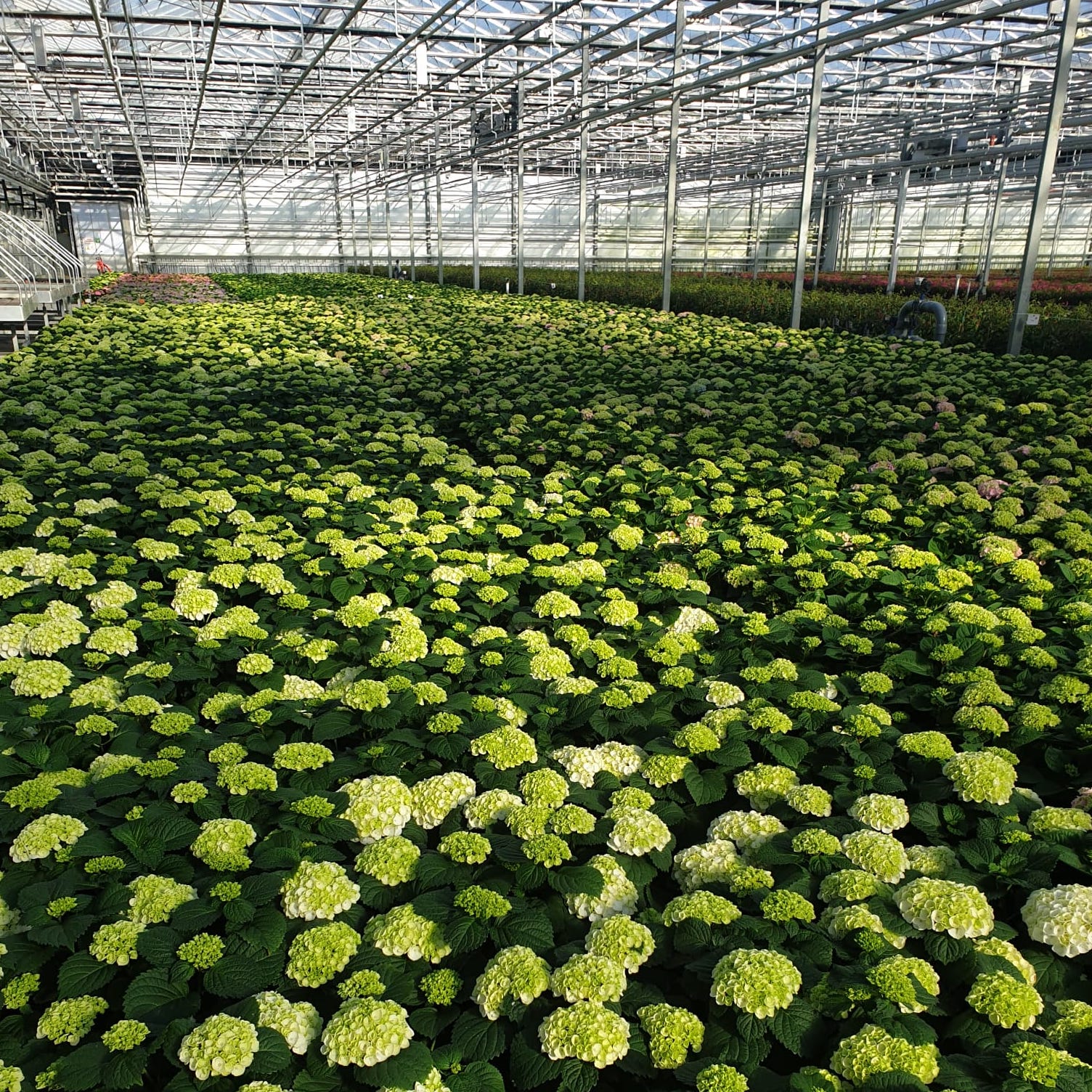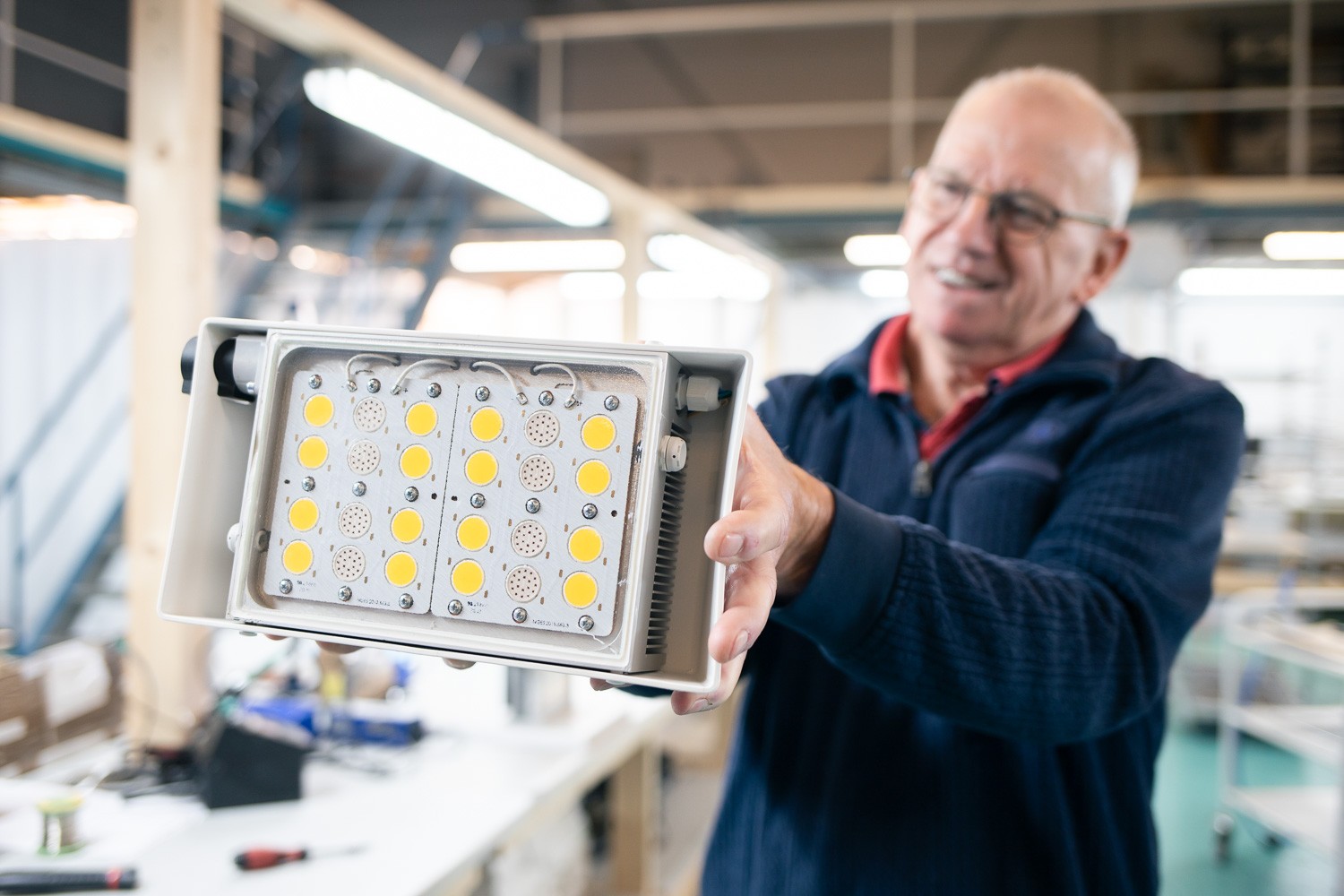“Less inhibitors, more gradual growth”
The purple flowers of the Bougainvillea contrast with the white light hanging above the crop in the greenhouse. The daylight spectrum provides such natural light that it took growers and their staff at the Huub van Leeuwen cultivation company in Naaldwijk some time to get used to it after years of working under SON-T. 144 1,000-watt full-LED fixtures equipped with a fan have been installed above 2,000 m2 of greenhouse area, where the grower is carrying out various tests in collaboration with the manufacturer Climalux.
The Bougainvillea is clearly enjoying itself. “During the day phase, we see an acceleration of the cultivation”, says Bart van Leeuwen, pointing to the purple sea of flowers. “Normally, this crop takes about 22 weeks, but now the plants are ready 1 to 2 weeks earlier.” He sees it in the reference trial under SON-T. “The acceleration is mainly in the moment of budding. Topping is always a stressful moment for the plant, but under these lights they sprout faster.”
However, the grower does not yet know whether he should be happy about it. “An accelerated cultivation means that the cultivation schedule would have to be changed. That has consequences for the whole process.” For now, it is an interesting conclusion, but he is not tying any follow-up actions to it yet. “We have to try things out and that takes time. In any case, we have now found that you can speed up this cultivation.”
Back to nature
The so-called CLX V1000 lamps have been hanging above the trial field since last October. The installation in the greenhouse is outdated and Van Leeuwen was looking for an alternative with new techniques, with which cultivation can be done in a more energy efficient and environmentally friendly way than with the current SON-T lighting.
It was the daylight spectrum of this lamp in particular that appealed to him, with which he could benefit especially in the winter months. “The philosophy of this lamp is: back to nature”, says advisor Niels Damen, who supports the technical implementation of the trial. “We think that is the best thing for the plant and for people. In nature, plants only have daylight and for humans daylight is also the most pleasant light to work under.”
The Climalux system design is based on a single power supply unit for each of the four 1,000-watt full-LED lamps. “The choice for that brightness meant that we had to design the lamp with external cooling,” explains Damen. A fan has been built in, which blows the heat from the lamp in a constant stream towards the crop. “The expectation is that the fan will create a more balanced humidity and a better microclimate around the plant, which can save energy.”
Dimmable system
Together with the grower, the manufacturer set up a trial field with French geranium, hydrangea, Bougainvillea and Bougainvillea cuttings under full-LED. In addition, a field of 6,000 square metres under SON-T was set up as a reference with the same crops and the same conditions. “At first I was mainly interested in shorter cultivation times, better quality, higher resistance and more branching,” says Van Leeuwen, “but after three weeks I had already thought of fifty more questions.
It’s not just lights on, lights off. The fittings have a dimmable system from 20 to 100 percent. “That means finding the right light intensity for the crop in question,” explains Damen. “You now have a whole palette of possibilities and so it is a search for a new balance.” What all the possible effects of the lamp on the plant and the crop are, all those involved are continuously investigating.
First results
When it comes to lower energy consumption, the results are clear. Compared to the reference, Van Leeuwen hardly needs to turn the tube heater on anymore. “The tube activity under these lamps is virtually zero. We only use these lamps and a low-grade floor heating system.”
The lamps consume as much electricity as SON-T, but the grower has twice as much light. Dimming also reduces energy consumption. Damen: “When you dim 50 per cent, the energy consumption also reduces by 50 per cent, while the lamp keeps itself at temperature.”
When it comes to the cultivation and the crop, the grower sees a clear difference. “We have planted several varieties of French geraniums, both under full-LED and under SON-T. In the full-LED trial, we had to brake two varieties twice. With the SON-T, we had to brake all species 6 to 10 times. So this means that with these full-LED lamps we need much less braking. At the same time, the plants here showed more branching and more leaf development in relation to the time period.
He observed the same result in the trials in Hydrangea. There, too, are stronger plants and the grower needs to use less inhibitor. “We see a stronger plant that has more time and energy to put into its development. The plant grows steadily all the time.”
Follow-up trials
The question now is: what causes these differences? “It seems that the plant structure and the root system develop better, which leads to a stronger plant above ground. We think that this calm growth is caused by the air flow,” says Damen. “We also see it in the development of the flower. The budding is there, but the flower is not squeezed out, so to speak”, adds the grower. “It’s much more gradual, but why?”
The set-up of a third trial in the summer period is therefore a logical follow-up to find an answer to that question. “We want to investigate whether the observed results are caused by the daylight spectrum or by the ventilator,” says Van Leeuwen. In concrete terms, this means that in this trial he wants to grow hydrangeas without the lighting, but with the use of the built-in ventilator. In this case, without light also means without heat from the lamp. “Perhaps the standard temperature can be lowered by 2 degrees. We will have to try that out.” Furthermore, he wants to further investigate the dimmability and therefore the light intensity, because maybe he can remove unwanted acceleration by doing so.
Interesting all year round
Is he not afraid of losing too much production by taking such unorthodox steps? “We can afford a delay,” says Van Leeuwen. “If we keep our finger on the pulse, we can make timely adjustments and adapt our strategy.”
In the meantime, he has discovered that it is not only the daylight spectrum that makes the lamp interesting. It is also the fan that concerns him greatly. “It is not cost-effective to buy lamps purely for supplemental lighting. Then they would be on for six months of the year and nothing else. That is not profitable. Now that we are harvesting heat and the fan ensures good distribution of that heat in the room and appears to have a regulating effect on the crop, this lamp suddenly becomes interesting for 12 months a year. And even using the built-in fans without the lamps on could still be effective at certain times of the year.”
Learning school
Flexibility and dedication are needed for the trial. “When you start something like this, you have to be open to trying new things. For years, we only cultivated with our green fingers. Now we rely on data and green fingers.”
That will be a learning curve, Van Leeuwen admits. “It’s exciting, but if we can eventually grow healthier and stronger crops with new techniques, reducing our energy consumption and our carbon footprint, then we will have achieved our goal.”




